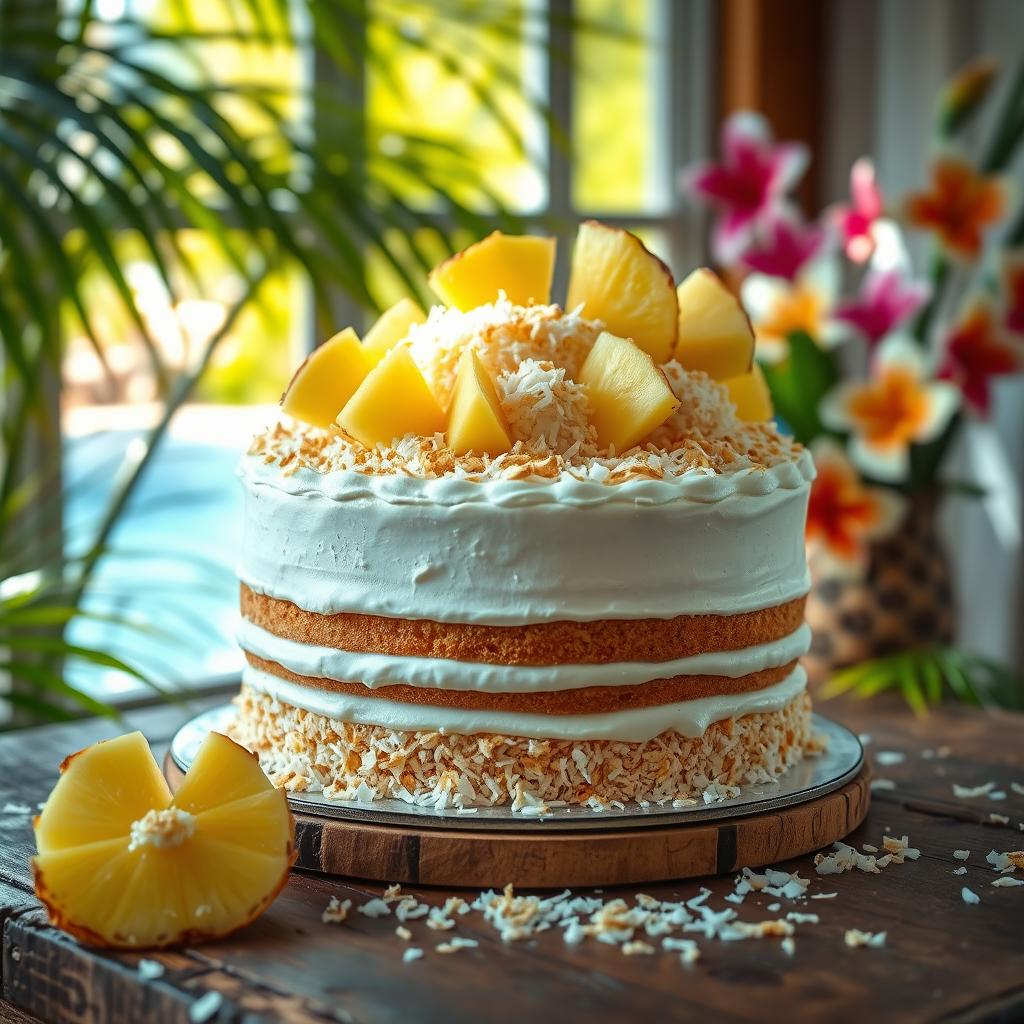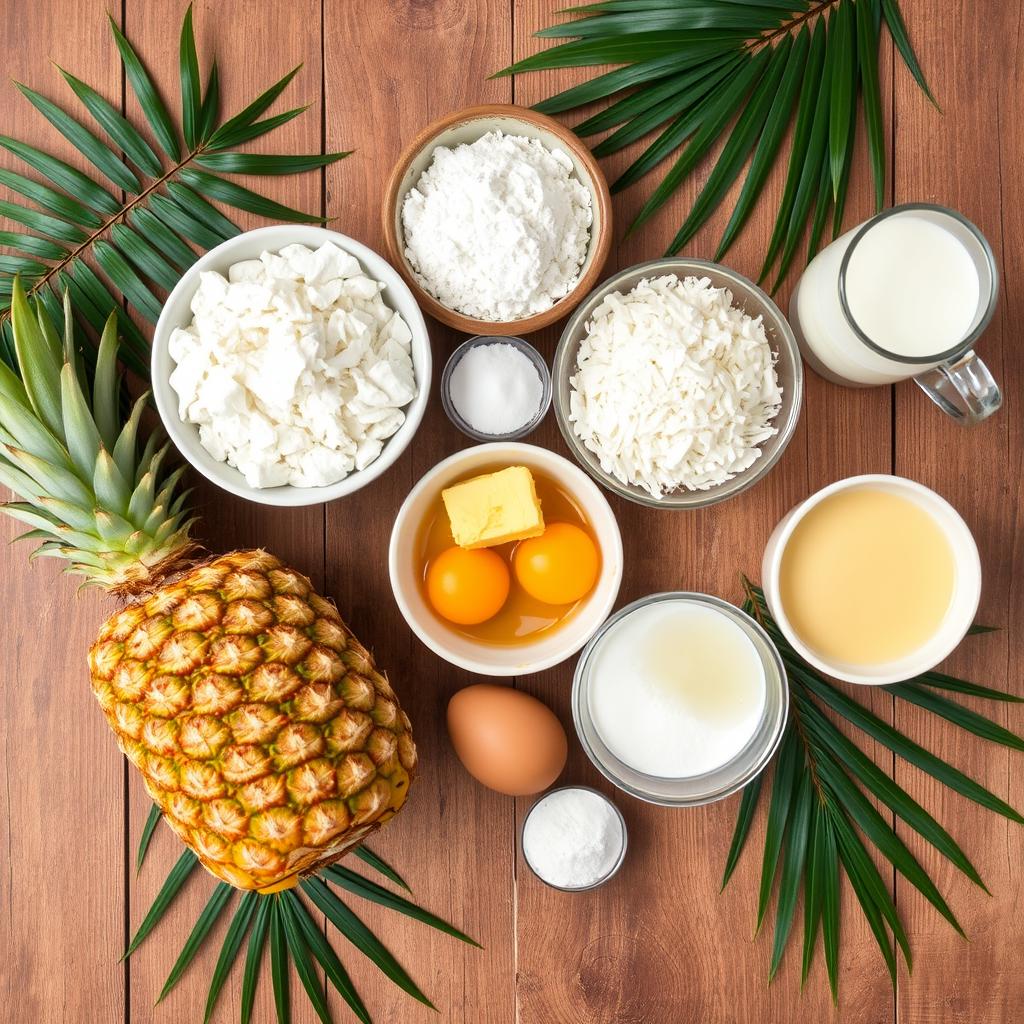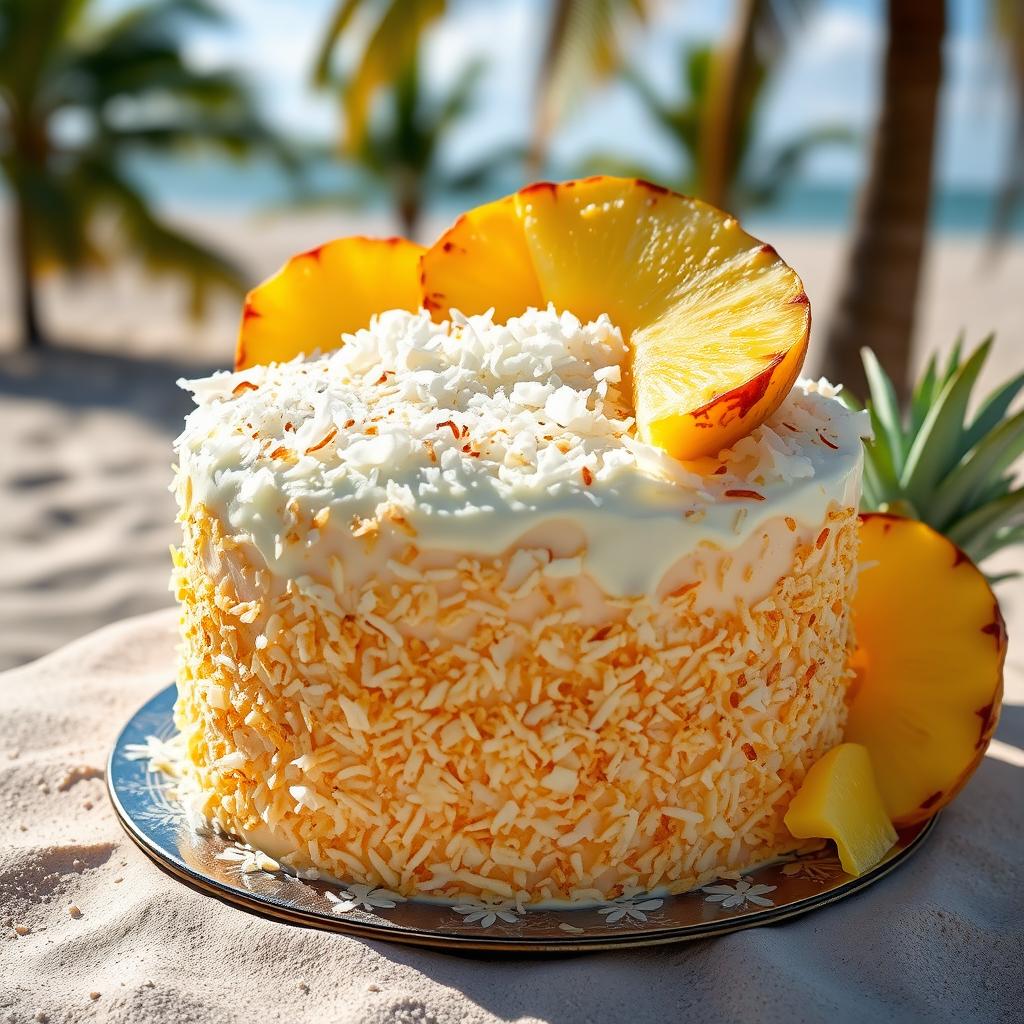Imagine biting into a slice of sunshine – that’s what a coconut and pineapple cake feels like. It brings the bright tastes of island food right to your home. This cake turns simple baking into a fun journey, filled with tropical flavors.
Tropical desserts take you to paradise with just one bite. Your coconut and pineapple cake is more than a recipe; it’s a celebration of island tastes. It’s perfect for summer parties or when you need a sweet getaway.
Key Takeaways
- Tropical desserts provide an exciting culinary experience
- Coconut and pineapple create a perfect flavor combination
- This cake suits various occasions from casual to elegant
- Island-inspired baking brings excitement to traditional recipes
- No special baking skills required to create this delightful treat
Introduction to Tropical Baking: The Perfect Island-Inspired Dessert
Tropical baking brings a slice of paradise to your kitchen. It turns ordinary desserts into extraordinary culinary experiences. The coconut and pineapple cake is a delightful journey through island-inspired flavors.

Origins of Tropical Cake Making
The roots of tropical baking go back to Hawaiian and Caribbean culinary traditions. Bakers in these regions found that local fruits like pineapple and coconut could create magical desserts. These ingredients turned simple cake recipes into vibrant, flavorful treats that celebrated the region’s natural bounty.
- Pineapple cultivation began in Hawaii in the late 1800s
- Coconut has been a staple ingredient in tropical cuisines for centuries
- Island baking techniques emphasize fresh, local ingredients
The Appeal of Island Flavors
Hawaiian inspired treats offer more than just taste—they provide a sensory escape. The sweet pineapple and rich coconut create a harmonious flavor profile. This combination transports you to a tropical paradise with every bite.
“Tropical desserts are like edible postcards from paradise” – Local Hawaiian Chef
Why This Combination Works
The magic of a coconut and pineapple cake lies in its perfect balance. Coconut’s creamy, rich texture complements pineapple’s bright, tangy sweetness. This exotic cake recipe creates a dessert that is both refreshing and indulgent, making it a crowd-pleaser for any occasion.
Whether you’re dreaming of a beach vacation or just want to bring some sunshine to your dessert table, this tropical cake promises an unforgettable culinary adventure.
Essential Ingredients for Your Coconut and Pineapple Cake
Making a delicious coconut pineapple cake needs the right ingredients. It’s all about picking fresh, vibrant parts. These parts make the coconut and pineapple flavors shine.

So, is pineapple and coconut a good mix? Absolutely! They blend sweet and tangy perfectly, making a tasty tropical treat.
- Fresh pineapple (preferably ripe and juicy)
- Unsweetened shredded coconut
- High-quality cake flour
- Granulated sugar
- Unsalted butter
- Large eggs
- Vanilla extract
Now, let’s look at what makes this cake special. The coconut custard recipe can give you more ideas for using these flavors.
| Ingredient | Quantity | Purpose |
|---|---|---|
| Fresh Pineapple | 1 cup, diced | Adds moisture and tropical sweetness |
| Shredded Coconut | 1/2 cup | Provides texture and rich flavor |
| Cake Flour | 2 cups | Creates light, tender crumb |
Pro tip: Use ingredients at room temperature for the best mix and cake texture. The mix of pineapple and coconut takes you to a sunny beach with every bite!
“The secret to an amazing coconut pineapple cake is using the freshest ingredients possible.” – Tropical Baking Experts
Kitchen Equipment and Preparation Tips
Making tasty fruity baked goods needs more than just good ingredients. Your kitchen setup is key to making the perfect coconut and pineapple cake. Getting ready properly turns baking into a special adventure.
Must-Have Baking Tools
Having the right tools in your kitchen is vital for tropical desserts. Here are the essential items:
- 9-inch round cake pans
- Stand mixer or hand mixer
- Silicone spatula
- Digital kitchen scale
- Cooling rack
- Offset spatula for frosting
Ingredient Temperature Guidelines
Keeping ingredients at the right temperature is key in baking. Here are some important temperature tips:
| Ingredient | Recommended Temperature | Why It Matters |
|---|---|---|
| Butter | Room temperature (65-70°F) | Ensures smooth mixing and even texture |
| Eggs | Room temperature | Promotes better incorporation and volume |
| Coconut milk | Room temperature | Prevents ingredient separation |
Workspace Organization
A tidy workspace makes baking easier. Mise en place – French for “everything in its place” – is your secret. Measure ingredients before starting, clear your area, and have tools ready.
“Baking is love made edible” – Unknown
By using these tips, you’ll be ready for tropical dessert success. Your coconut and pineapple cake will be more than a recipe. It will be a wonderful culinary journey.
Step-by-Step Mixing and Baking Process
Making a tasty coconut and pineapple cake needs precision and care. The secret to a great tropical dessert is blending ingredients just right. Wondering if you can use pineapple juice instead of water in a cake mix? Yes, you can!
First, collect your ingredients and make sure they’re at room temperature. This makes the batter smoother and the cake texture better. For your coconut and pineapple cake, follow these steps:
- Preheat your oven to 350°F (175°C)
- Grease your cake pan well
- Sift dry ingredients to remove lumps
- Mix wet ingredients separately before combining
When using pineapple juice, replace water with an equal amount of fresh juice. This adds more moisture and boosts the tropical flavor of your cake. Experts suggest using high-quality cake mix for the best taste.
“The magic of baking is in the details and the love you put into each step.” – Baking Enthusiast
Mix your batter gently to avoid overworking it. Add shredded coconut for extra texture and tropical taste. Bake for 25-30 minutes, checking with a toothpick for doneness.
Creating the Perfect Tropical Frosting
Your exotic cake recipe comes to life with the right frosting technique. The tropical frosting turns a simple cake into a stunning dessert. It captures island flavors and delights the senses.
Crafting the perfect frosting needs precision and creativity. Each layer of frosting adds depth and character to your coconut and pineapple cake.
Mastering Frosting Consistency
Achieving the right frosting consistency is key for a professional-looking cake. Follow these tips:
- Room temperature ingredients ensure smooth blending
- Use a stand mixer for optimal texture
- Adjust liquid ingredients gradually
- Chill frosting for 15-20 minutes before application
Elegant Decoration Techniques
Transform your cake into a visual masterpiece with these decoration strategies:
- Use piping bags with different tips
- Create tropical flower designs
- Incorporate toasted coconut flakes
- Garnish with fresh pineapple chunks
Proper Storage Methods
| Storage Location | Temperature | Duration |
|---|---|---|
| Refrigerator | 35-40°F | 3-4 days |
| Room Temperature | 68-72°F | 24-48 hours |
| Freezer | 0°F | Up to 2 weeks |
Pro tip: Always cover your frosted cake to maintain moisture and prevent absorbing refrigerator odors.
“Great frosting is the secret ingredient that elevates a good cake to an unforgettable dessert.” – Pastry Chef Maria Rodriguez
Troubleshooting Common Baking Issues
Baking a perfect coconut and pineapple cake can be tough. Knowing why your coconut cake might be dense and how changing ingredients affects it is key. It helps make a tasty tropical dessert.
When wondering why your coconut cake is dense, several things matter. Overmixing, wrong flour amounts, or bad ingredient temperatures can make it heavy.
- Overmixing develops excess gluten, making cakes dense
- Incorrect flour measurements can change cake structure
- Room temperature ingredients blend more smoothly
What if you use milk instead of water in a cake? Milk can change your cake’s texture and taste. Water adds just moisture, but milk brings richness and fat, which can make it denser.
| Ingredient | Effect on Cake | Recommended Action |
|---|---|---|
| Water | Neutral moisture | Standard recipe requirement |
| Milk | Richer texture, potential density | Use sparingly, adjust other ingredients |
“Precision is the baker’s secret weapon” – Professional Pastry Chef
To avoid dense cakes, measure ingredients carefully and don’t overmix. Make sure ingredients are at the right temperature. When trying different ingredients, do it carefully to keep your cake light and fluffy.
Flavor Variations and Creative Twists
Take your coconut and pineapple cake to new heights. Add a splash of creativity to turn a classic into a masterpiece. It’s a journey that will excite your taste buds and celebrate Hawaiian flavors.
Alternative Fruit Combinations
Try mixing fruits to give your cake a fresh twist. Here are some ideas:
- Mango and passion fruit for a vibrant tropical twist
- Guava and coconut for a uniquely Caribbean flavor profile
- Papaya and lime for a tangy, refreshing variation
Dietary Modifications
Make your favorite dessert fit any diet without losing flavor:
| Dietary Requirement | Substitution |
|---|---|
| Gluten-Free | Almond flour or gluten-free flour blend |
| Vegan | Coconut milk, flax eggs, plant-based butter |
| Low-Sugar | Stevia or monk fruit sweetener |
Enhancing Pineapple Flavor
Want to boost your pineapple flavor? Here’s how:
- Use fresh pineapple juice instead of canned
- Reduce pineapple juice on the stovetop for concentrated flavor
- Add a splash of rum for depth and complexity
“The secret to an unforgettable tropical dessert lies in bold, authentic flavors.” – Culinary Chef
With these creative ideas, your cake becomes a journey through tropical landscapes.
Tips for Special Occasions and Events
Planning a tropical-themed celebration? Your coconut and pineapple cake can be the star of any special event. It’s perfect for a luau party dessert that will wow your guests. Knowing the traditional names and presentation styles can make your dessert experience even better.
Different cultures have unique names for pineapple-based cakes. In Hawaii, these treats are called haupia cake or pineapple upside-down cake. Each name adds a special cultural twist to the classic tropical dessert.
- Luau Party Presentation Ideas:
- Decorate with fresh tropical flowers
- Serve on banana leaves
- Garnish with edible orchids
- Event-Specific Styling:
- Beach weddings
- Birthday celebrations
- Summer gatherings
“A great cake tells a story of tradition, flavor, and celebration.” – Pastry Chef Maria Rodriguez
When hosting a luau party dessert, consider these serving recommendations to make your pineapple cake truly memorable:
| Event Type | Cake Presentation Style | Recommended Garnish |
|---|---|---|
| Intimate Gathering | Individual Plated Slices | Toasted Coconut Flakes |
| Large Luau Party | Tiered Cake Display | Fresh Pineapple Wedges |
| Corporate Event | Elegant Cake Squares | Edible Gold Leaf |
Knowing what the pineapple cake is called in different contexts can help you create an authentic and exciting dessert experience. It will transport your guests to a tropical paradise.
Conclusion
Making a coconut and pineapple cake turns your kitchen into a tropical paradise. It’s a journey that celebrates the rich, vibrant island flavors. Each slice is more than a sweet treat; it’s a taste of adventure that connects you to warm, sunny places.
This tropical dessert is versatile, letting you experiment and make it your own. You can adapt it for dietary needs or try new ingredients. Your coconut and pineapple cake can show off your creativity while keeping its delicious core.
We invite you to dive into the world of island baking. Your kitchen becomes a place for creativity, blending old techniques with new ideas. The coconut and pineapple cake is more than a recipe; it’s a chance to enjoy baking and share tropical joy with loved ones.
Baking is an art, and each time you make this dessert, you’ll get better. Your passion and creativity will make every bite of this tropical treat special.
FAQ
Is pineapple and coconut a good combination for a cake?
Absolutely! Pineapple and coconut are a classic tropical flavor pairing. They work wonderfully in cakes. The sweet, tangy pineapple complements the rich, creamy coconut.
This creates a harmonious and refreshing taste. It evokes memories of island vacations.
Can I use pineapple juice instead of water in a cake mix?
Yes, you can substitute pineapple juice for water. This adds depth and moisture to your cake. It intensifies the tropical taste.
Just use the same quantity of pineapple juice as water in the original recipe.
Why is my coconut cake dense?
A dense coconut cake can result from several factors. Overmixing the batter, using cold ingredients, or not incorporating enough air are common causes.
To achieve a light, fluffy texture, ensure your ingredients are at room temperature. Mix just until combined. Use the creaming method to incorporate air into the batter.
What happens if I use milk instead of water in a cake?
Using milk instead of water can make your cake richer, more moist, and more flavorful. Milk adds fat and protein, creating a softer, more tender crumb.
However, this substitution might slightly alter the cake’s texture. You might need to make minor adjustments to other ingredients.
How can I enhance my pineapple flavor?
To boost the pineapple flavor, try adding pineapple extract. Use crushed pineapple in the batter. Brush the cake layers with pineapple juice.
You can also incorporate dried pineapple pieces. Create a pineapple compote to layer between cake tiers for an extra burst of tropical taste.
What is a traditional pineapple cake called?
In Hawaiian cuisine, a similar cake is often called a “Pineapple Upside-Down Cake.” It features caramelized pineapple rings on top of a butter cake.
In other cultures, variations like the Hummingbird Cake incorporate both pineapple and coconut flavors.
Are there any dietary modifications for this cake?
Yes, you can adapt the coconut and pineapple cake for various dietary needs. For a gluten-free version, use gluten-free flour blend.
To make it dairy-free, substitute butter with coconut oil and use non-dairy milk. Vegan options can be created by using egg substitutes like applesauce or flax eggs.

